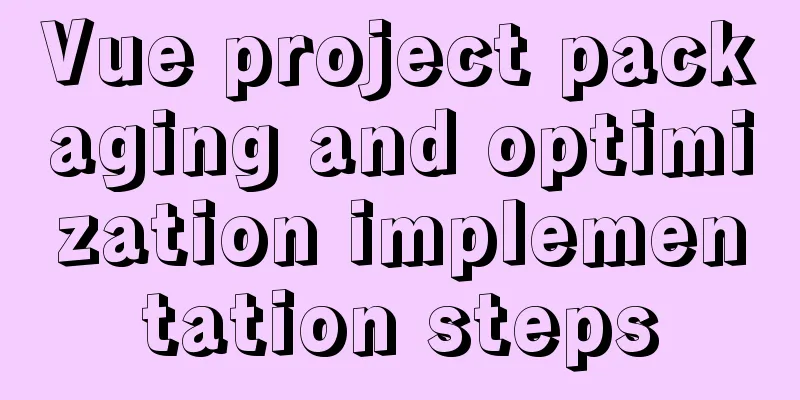Vue project packaging and optimization implementation steps

Packaging, launching and optimizing the Vue project
Packaging of Vue project
Open the terminal and switch to the project root directory Enter the command: A dist folder will be generated in the root directory of the current project, which contains the packaged files
Project hosting
express create server
var express = require('express')
const path = require('path')
// 2. Create the server var app = express();
// Hosting static resources // You can also place all static resources in a specified directory, such as public, and then add the following configuration app.use(express.static('dist'))
app.use('/', express.static(path.join(__dirname, 'dist')))
// 3. Start the server and listen to the port app.listen(3001, () => {
console.log('http://127.0.0.1:3001')
})
Start the server
Common optimization of projects
Generate project report files npm run build – --report
Open the report page
1. In the report page, the larger the block, the larger the volume occupied by the template. CDN acceleration optimization
vue.config.js
Add package exclusions
module.exports = {
configureWebpack: {
externals:{
'vue': 'Vue',
'element-ui': 'ELEMENT',
'quill': 'Quill'
}
},
}
As you can see, the size of the packaged project is significantly reduced, but the problem is not solved. Without these packages, the packaged project cannot be run.
This is because there is no Vue package in the packaged project, so an error occurs. We now need to use CDN to provide these resources. Add user customization of CDN Add the following code to vue.config.js
let cdn = {
css: [
//element-ui css
'https://unpkg.com/element-ui/lib/theme-chalk/index.css', // Style sheet // Rich text box plug-in style 'https://cdn.bootcdn.net/ajax/libs/quill/2.0.0-dev.4/quill.bubble.css'
],
js: [
// vue must be at first!
'https://unpkg.com/vue/dist/vue.js', // vuejs
// element-ui js
'https://unpkg.com/element-ui/lib/index.js', // elementUI
// Rich text box plug-in 'https://cdn.bootcdn.net/ajax/libs/quill/2.0.0-dev.4/quill.js'
]
}
Automatically add resources to the page through plugins Mount resources to plugins
module.exports = {
// Add packaging exclusions to indicate that the packages in the following configuration will not be packaged into the project in the future configureWebpack: {
externals:{
'vue': 'Vue',
'element-ui': 'ELEMENT',
'quill': 'Quill'
}
},
//Mount the CDN resources to the plugin chainWebpack (config) {
config.plugin('html').tap(args => {
args[0].cdn = cdn
return args
})
}
}
Use the plug-in to add the specified CDN resource in the page, and add the following code to the public index in the project (the index file before the project is packaged) Add css import (in head structure)
<% for(var css of htmlWebpackPlugin.options.cdn.css) { %>
<link rel="stylesheet" href="<%=css%>" />
<% } %>
Add js import (in body structure)
<% for(var js of htmlWebpackPlugin.options.cdn.js) { %>
<script src="<%=js%>"></script>
<% } %>
Repack, OK Set to use CDN only in production stage
const isProd = process.env.NODE_ENV === 'production' // Is it a production environment? let externals = {
'vue': 'Vue',
'element-ui': 'ELEMENT',
'quill': 'Quill'
}
let cdn = {
css: [
//element-ui css
'https://unpkg.com/element-ui/lib/theme-chalk/index.css', // Style sheet // Rich text box plug-in style 'https://cdn.bootcdn.net/ajax/libs/quill/2.0.0-dev.4/quill.bubble.css'
],
js: [
// vue must be at first!
'https://unpkg.com/vue/dist/vue.js', // vuejs
// element-ui js
'https://unpkg.com/element-ui/lib/index.js', // elementUI
// Rich text box plug-in 'https://cdn.bootcdn.net/ajax/libs/quill/2.0.0-dev.4/quill.js'
]
}
cdn = isProd ? cdn : { css: [], js: [] }
externals = isProd ? externals : {}
module.exports = {
// Add packaging exclusions to indicate that the packages in the following configuration will not be packaged into the project in the future configureWebpack: {
externals
},
//
chainWebpack (config) {
config.plugin('html').tap(args => {
args[0].cdn = cdn
return args
})
}
}This concludes this article on the implementation steps of vue project packaging and optimization. For more relevant vue project packaging and optimization content, please search for previous articles on 123WORDPRESS.COM or continue to browse the following related articles. I hope everyone will support 123WORDPRESS.COM in the future! You may also be interested in:
|
<<: Tutorial on installing and using virtualenv in Deepin
>>: Solving problems encountered when importing and exporting Mysql
Recommend
Detailed explanation of using the at command for one-time scheduled tasks in Linux
Table of contents Preface 1. Introduction to one-...
Discussion on the browsing design method of web page content
<br />For an article on a content page, if t...
Web page html special symbols html special characters comparison table
Special symbols Named Entities Decimal encoding S...
Steps to transfer files and folders between two Linux servers
Today I was dealing with the issue of migrating a...
Detailed explanation of the reasons and solutions for Docker failing to start normally
1. Abnormal performance of Docker startup: 1. The...
js to achieve the effect of light switch
This article example shares the specific code of ...
How to use MySQL binlog to restore accidentally deleted databases
Table of contents 1 View the current database con...
How to place large images in a small space on a web page
Original source: www.bamagazine.com There are nar...
Several ways to center a box in Web development
1. Record several methods of centering the box: 1...
Summary of MySQL 8.0 Online DDL Quick Column Addition
Table of contents Problem Description Historical ...
Design Tips: We think you will like it
<br />Looking at this title, you may find it...
Implementation of CSS sticky footer classic layout
What is a sticky footer layout? Our common web pa...
Mysql master-slave synchronization configuration scheme under Centos7 system
Preface Recently, when working on a high-availabi...
The Complete List of MIME Types
What is MIME TYPE? 1. First, we need to understan...
A brief discussion on the corresponding versions of node node-sass sass-loader
Table of contents The node version does not corre...

![[External link image transfer failed. The source site may have an anti-hotlink mechanism. It is recommended to save the image and upload it directly (img-woOTHmF2-1627475455630) (img\02-access server resources.jpg)]](upload/2022/web/202107300820542.jpg)













